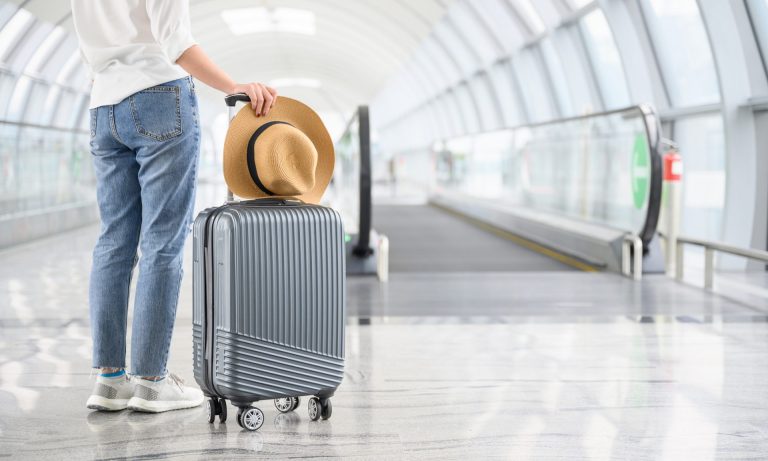Table of Contents
ToggleEver been at the airport, lugging around your big suitcase and wondering, “Can I bring all this stuff?” No worries, we’ve got your back! This guide will help you understand checked baggage rules super easily. When you’re done reading, you’ll be a total pro, and extra baggage fees will be a thing of the past. So, let’s kick it off with the basics!
What Is A Checked Baggage?
It’s your stuff that you give to the airline at the check-in counter. You hand it over, and it disappears like a rabbit in a magician’s hat. But don’t worry, it’s not magic; it’s just on its way to meet you at your destination.
When you check your luggage, the airline takes it and loads onto the same plane you’re flying on. So, while you’re in your seat, it’s stowed away safely in the plane’s belly. When you land at your destination, your checked baggage will reappear. It’s like your stuff goes on its own little adventure while you’re up in the sky, and then it’s reunited with you when you touch down.
Weight Limit For A Checked Baggage
Airlines aren’t big fans of lifting heavy stuff, so they’ve set some rules. These rules can be a bit different for each airline. For example, Virgin Atlantic flights might have their own rules. So, it’s smart to always search online and find out what’s what.
Usually, most airlines have a limit of around 50 pounds (that’s about 23 kilograms), but this can change depending on your ticket type and which airline you’re flying with. But why these limits? Well, airplanes must stay balanced in the sky, and if the baggage is too heavy, it can mess things up. Yep, you might have to pay extra fees.
The Standard Size Of A Checked Baggage
The size can change depending on your airline, so look up their rules. Generally, a typical checked bag shouldn’t be larger than 62 inches (that’s about 158 centimetres) in total size. To figure this out, add up how tall, wide, and deep your bag is. For example:
✅ 24 inches (height) + 20 inches (width) + 18 inches (depth) = 62 inches
✅ 26 inches (height) + 22 inches (width) + 14 inches (depth) = 62 inches
But be careful not to go overboard:
❌ 30 inches (height) + 22 inches (width) + 14 inches (depth) = 66 inches
That’s too big for most airlines! So, when you’re packing, keep your bag’s total size under 62 inches to avoid any size-related issues at the airport.
Tips On How To Fly With Checked Baggage
Here are some handy tricks to keep in mind:
1. Know the Rules
We all know that each airline has its own unique rules. So, looking up all the info and rules is a good idea before you start packing. For example, you can search for Virgin Atlantic baggage allowance to learn what you need to know. Knowing these rules will help you save time and effort.
2. Add A Tracker To Your Bags
We know losing our luggage is a nightmare. But now, all you have to do is attach a tracker to each bag. This way, if one of your bags pulls a disappearing act, you’ll know exactly where it is.
3. Remember The Worst Case Scenario When Packing
Picture this: you walk to the airport, and your suitcase feels super duper-heavy. Not a great start, right? When you’re packing, place the important stuff at the bottom of your suitcase. If you ever need to make your luggage lighter, you can simply remove or shift the things you don’t need, especially if they’re on top of your suitcase.
4. Always Come To The Airport Early
Running around all stressed out is a bummer, especially when trying to catch a flight with your checked luggage. So, make it a regular thing to get to the airport early. This way, you’ll have much time for surprise issues or super long lines at the check-in counter.
What is Not Allowed In A Checked Baggage?
There are some things that airlines are strict about, they are:
1. Flammable Items
Airlines are all about safety. So, they say a big “No!” to things that could cause a fire or explosion on the plane. That means no fireworks, gas cylinders, or lighter fluid in your checked baggage.
2. Dangerous Weapons
This one’s pretty straightforward. You can’t pack dangerous weapons like ninja swords or nunchucks in your checked baggage. But to be crystal clear, even sharp objects like knives and box cutters are a big no-no.
3. Hazardous Chemicals
Don’t toss chemicals in your checked bag unless you’re like a scientist on a mission. Things like bleach, explosives, and radioactive stuff should be kept far away from your suitcase.
4. Perishable Foods
As much as you love your smelly cheese and stinky fish, they aren’t great flight buddies. Those tasty treats are better off in your carry-on bag.
Long Story Short
We’ve covered the whole deal about checked baggage allowances for the big airlines. Just remember, you’ve got to check the rules of the airline you’re going to fly with and pack your stuff carefully. With some good planning and our cool tips, you’ll become an airport expert in a jiffy. Have a safe journey, and may your bags always arrive where they should!



